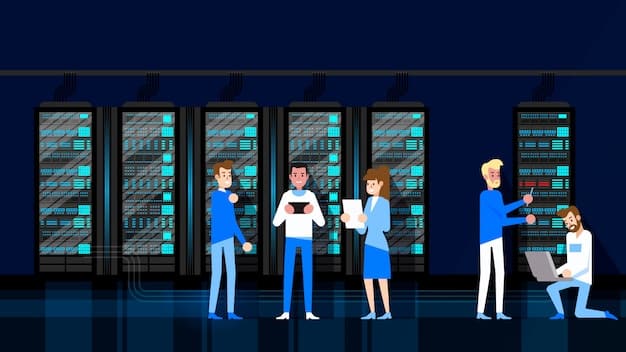How 5G Network Slicing Will Revolutionize US Mobile Experiences by 2025

By 2025, 5G network slicing will revolutionize US mobile experiences by enabling carriers to create virtual, customized network segments tailored for specific applications, greatly enhancing performance and allowing for new services across various industries.
The dawn of 5G has promised a new era of connectivity, but its full potential is only now beginning to unfold. Central to this transformation is 5G network slicing, a groundbreaking technology set to redefine how mobile experiences are delivered across the United States by 2025. This advancement moves beyond mere speed upgrades, heralding an era of highly customized and optimized network performance for a myriad of applications.
Understanding 5G Network Slicing
Network slicing is a fundamental architectural concept in 5G, allowing a single physical network infrastructure to be partitioned into multiple virtual networks, each optimized for specific services, applications, or customers. This isn’t just about dividing bandwidth; it’s about creating entirely independent and customized operational environments within the same physical network.
Imagine the internet not as a single highway, but as countless dedicated lanes, each designed for a particular type of vehicle and destination. That’s the essence of network slicing. Each “slice” can have its own dedicated resources, including bandwidth, latency, and security protocols, precisely tailored to meet the demands of a given use case.
The Core Principles of Network Slicing
At its heart, 5G network slicing relies on several key technological innovations that make this partitioning possible. These principles enable the dynamic creation and management of diverse virtual networks.
- Software-Defined Networking (SDN): SDN separates the control plane from the data plane, allowing network administrators to manage network services through a centralized, software-based controller. This flexibility is crucial for configuring slices dynamically.
- Network Functions Virtualization (NFV): NFV decouples network functions, such as routing and firewalls, from proprietary hardware and runs them as software on standard servers. This reduces costs and increases agility, making it easier to deploy and scale different slices.
- Orchestration and Automation: Advanced orchestration systems are vital for automating the creation, deployment, and management of network slices. This ensures that slices can be provisioned and adjusted in real-time based on demand.
This level of granularity means that a carrier can, for instance, dedicate a super-low-latency slice for autonomous vehicles, another high-bandwidth slice for augmented reality applications, and a highly secure slice for critical public safety communications, all operating simultaneously on the same physical infrastructure.
The implications for performance and service delivery are profound, promising an era where network capabilities are far more responsive and finely tuned to user needs than ever before. This foundational concept underpins the revolution coming to US mobile experiences.
Transforming Consumer Mobile Experiences
By 2025, 5G network slicing is poised to fundamentally alter how US consumers interact with their mobile devices and the digital world. The benefits will extend far beyond faster download speeds, touching every aspect of daily digital life.
One of the most immediate impacts will be on entertainment and media consumption. Imagine streaming 8K video or engaging in cloud gaming with virtually no lag, irrespective of how many other users are online or what other applications are running. Network slicing can guarantee dedicated bandwidth and ultra-low latency for these demanding applications, ensuring a consistently premium experience.
Enhanced Gaming and Augmented Reality
For mobile gamers, especially those involved in e-sports or graphics-intensive titles, network slicing will be a game-changer. Latency, often the bane of competitive online gaming, can be drastically reduced, virtually eliminating lag. This means more responsive controls and a seamless, immersive gaming environment.
- Cloud Gaming: Dedicated slices will ensure high-fidelity graphics and instant feedback, making cloud gaming on mobile devices indistinguishable from console experiences.
- Augmented Reality (AR): AR applications, from immersive retail experiences to interactive education, demand high bandwidth and ultra-low latency to overlay digital content seamlessly onto the real world. Network slices can provide these precise QoS (Quality of Service) guarantees.
- Virtual Reality (VR): While still nascent for widespread mobile adoption, VR applications will also benefit immensely, offering truly immersive and untethered experiences without motion sickness caused by lag.
Beyond entertainment, slicing will also improve everyday mobile usage. Think of guaranteed performance for video calls, ensuring crystal-clear audio and video without drops, even in crowded areas. Public safety alerts could be prioritized, ensuring they reach devices instantly, regardless of network congestion.

This tailored approach will mean an end to the “one-size-fits-all” network model, where all data traffic is treated equally. Instead, critical applications will always receive the resources they need, leading to a much more reliable and predictable mobile experience for all users.
Industrial and Enterprise Applications Unleashed
The business world stands to gain immensely from 5G network slicing, driving efficiency, innovation, and entirely new service models across various sectors by 2025. This technology offers enterprises the ability to secure and optimize their digital operations like never before.
Consider critical infrastructure management, where the smallest delay can have catastrophic consequences. With network slicing, utilities can create highly isolated and reliable slices for remotely monitoring grids, controlling power distribution, and even managing smart city sensors. The guaranteed low latency and high reliability are non-negotiable in such scenarios.
Key Industry Transformations
Several industries are poised for significant disruption and efficiency gains through the adoption of network slicing.
- Manufacturing and Logistics: Factories can implement private 5G networks, using slices for real-time control of robotic arms, automated guided vehicles (AGVs), and predictive maintenance sensors. This enables “Industry 4.0” initiatives like digital twins and highly automated production lines.
- Healthcare: Remote surgeries performed by robots, real-time patient monitoring via connected medical devices, and intelligent ambulance services all require ultra-reliable, low-latency communication. Network slices can guarantee the performance levels demanded by these life-critical applications.
- Automotive: Autonomous vehicles rely on split-second communication with other vehicles (V2V), roadside infrastructure (V2I), and centralized traffic management systems. A dedicated, high-priority network slice can ensure this data exchange happens instantly and reliably, crucial for safety and navigation.
- Agriculture: Smart farming solutions, including IoT sensors for crop monitoring, automated irrigation systems, and drone-based surveillance, can leverage slices to ensure consistent connectivity across large, remote areas, optimizing yields and resource usage.
The ability for enterprises to procure logically isolated “private networks” over a shared public 5G infrastructure significantly lowers costs compared to deploying entirely separate physical networks. This democratizes access to advanced connectivity, allowing businesses of all sizes to leverage cutting-edge 5G capabilities tailored to their specific operational needs, fostering innovation and competitive advantage.
Security and Reliability with Sliced Networks
Beyond performance, 5G network slicing offers substantial improvements in security and reliability, critical factors for the widespread adoption of advanced mobile applications, particularly in enterprise and public safety domains. By 2025, these enhancements will be central to trust in US mobile networks.
Each network slice operates as an independent logical network. This inherent isolation provides a powerful security benefit: a breach or attack on one slice does not necessarily compromise other slices. This “sandbox” effect limits the blast radius of cyber threats, making the overall network more resilient.
Enhanced Security Measures
The architecture of network slicing allows for tailored security protocols to be implemented for each slice, aligning with the specific requirements of the applications running within it.
- Isolation: Logical separation ensures that traffic and data from one slice cannot easily access or interfere with another. This is crucial for protecting sensitive data and critical operations.
- Customized Security Policies: Enterprises can define highly specific security policies, firewalls, and encryption standards for their dedicated slices, optimizing protection for their unique data and operational risks.
- Reduced Attack Surface: By allowing only authorized traffic and services within a slice, the potential attack surface is significantly reduced compared to a generalized, open network.
Reliability is equally paramount. For mission-critical applications like remote surgery or emergency services, network uptime and consistent performance are non-negotiable. Network slicing enables carriers to dedicate resources and establish service level agreements (SLAs) for reliability that are simply not possible with conventional, shared network architectures.
Should a part of the physical network experience an issue, an intelligent orchestration system can automatically reroute traffic and reallocate resources to maintain the integrity and performance of critical slices. This built-in redundancy and flexibility ensure that essential services remain operational, even under adverse conditions, making 5G networks inherently more robust and trustworthy for the most demanding applications in the US.
Challenges and the Path to Widespread Adoption
While the promise of 5G network slicing is immense, its widespread implementation and optimization across US mobile networks by 2025 face several technical, operational, and commercial hurdles. Overcoming these challenges is crucial for realizing its full potential.
One primary challenge is the complexity of orchestrating and managing a multitude of virtual networks on a single physical infrastructure. This requires sophisticated software platforms, advanced automation tools, and highly skilled personnel to design, deploy, and maintain these dynamic slices in real-time.
Overcoming Deployment Hurdles
The path to pervasive network slicing will require significant investment and innovation from network operators, vendors, and regulatory bodies.
- Interoperability: Ensuring that slices can seamlessly interact across different network equipment vendors and even between different operators is a complex technical challenge that requires standardized interfaces and protocols.
- Standardization: While 3GPP has laid the groundwork, ongoing standardization efforts are needed to ensure global compatibility and ease of deployment for new slicing capabilities.
- Resource Management: Dynamically allocating and scaling resources for thousands of concurrent slices without impacting overall network performance requires highly intelligent and automated resource management systems.
Commercial models also present a hurdle. Operators need to define clear pricing strategies for different types of slices, based on parameters like bandwidth, latency, reliability, and security levels. This will involve innovative business models that move beyond simple data plans and cater to the specific needs of enterprise customers.

Regulatory frameworks also need to evolve to address questions of net neutrality, quality of service guarantees, and liability in a sliced network environment. Policy makers will need to work alongside industry to ensure that competition is fostered while protecting consumer interests and facilitating innovation.
Despite these challenges, the industry is making significant strides. Ongoing trials, technological advancements, and collaborative efforts between operators and technology providers are gradually paving the way for network slicing to become a cornerstone of US 5G infrastructure, with significant progress expected by 2025.
Economic Impact and New Business Models
The advent of 5G network slicing is not merely a technological upgrade; it’s an economic catalyst set to generate new revenue streams, foster innovation, and reshape business models across the US economy by 2025. It moves beyond consumer-centric data plans to a more intricate, value-driven service offering.
For mobile network operators (MNOs), network slicing provides a powerful tool for differentiation and premium service offerings. Instead of competing solely on price and basic data allowances, MNOs can offer highly specialized slices tailored to specific enterprise needs, commanding higher average revenue per user (ARPU).
Unlocking New Market Opportunities
The flexibility and customization offered by network slicing will unlock entirely new market segments and foster an ecosystem of innovative services.
- Vertical Industry Monetization: Operators can partner directly with industries (e.g., manufacturing, logistics, healthcare) to provide customized private 5G networks as a service, offering SLA-backed performance guarantees.
- Developer Ecosystems: A developer could potentially “rent” a network slice with specific characteristics (e.g., ultra-low latency) to build and deploy innovative applications that require guaranteed performance, fostering a new breed of services.
- Edge Computing Integration: Slices can be tightly integrated with edge computing infrastructure, allowing for data processing closer to the source, reducing latency and enabling real-time applications like autonomous robotics or interactive AR experiences.
This paradigm shift will encourage enterprises to invest more in digital transformation, as they can now rely on a mobile network infrastructure that is precisely tuned to their operational requirements. Small and medium-sized businesses (SMBs) will also benefit, as they gain access to enterprise-grade connectivity without the prohibitive costs of building their own private networks.
The economic impact will ripple through the entire tech ecosystem, stimulating investment in 5G-enabled devices, application development, and specialized services that leverage the unique capabilities of network slicing. This creates a fertile ground for innovation and economic growth, ultimately benefiting the broader US economy through new jobs and enhanced productivity.
Looking Ahead: 5G Slicing Beyond 2025
While 2025 marks a pivotal year for the foundational adoption of 5G network slicing in the US, the technology’s evolution and impact will continue to grow exponentially in the years that follow. The initial implementations will pave the way for even more sophisticated and dynamic network capabilities.
One key trend beyond 2025 will be the increased automation and AI-driven management of network slices. Machine learning algorithms will be routinely used to predict demand, dynamically allocate resources, and self-heal slices in response to network anomalies, leading to unprecedented levels of efficiency and reliability.
Future Developments and Potential
The long-term vision for network slicing involves a deeply integrated, highly intelligent network infrastructure, capable of supporting the most ambitious technological advancements.
- Slicing as a Service (SlaaS): Enterprises and even individual developers will gain the ability to provision and manage their own slices through user-friendly portals, much like cloud computing resources are consumed today.
Network-as-a-Platform: The network itself will become a programmable platform, where new applications and services can “plug into” specific slices with guaranteed performance, fostering an even richer innovation ecosystem.- Cross-Operator Slicing: Future advancements will likely involve the ability to seamlessly stitch together slices across different MNOs, ensuring end-to-end performance for applications that traverse multiple network boundaries, crucial for national-scale or global services.
The integration of satellite 5G, advanced edge computing, and new generations of IoT devices will further amplify the need for flexible and customizable network segmentation. Network slicing will evolve to support these diverse access technologies and device types, creating a truly ubiquitous and intelligent connectivity fabric.
Ultimately, 5G network slicing is not a static technology but a dynamic framework that will continually adapt to meet the demands of an increasingly connected and digitalized world. Its journey beyond 2025 will be characterized by continuous innovation, pushing the boundaries of what mobile networks can achieve and profoundly shaping the digital experiences of the future across the United States.
| Key Aspect | Brief Description |
|---|---|
| 🚀 Customized Performance | Network slices offer tailored bandwidth, latency, and security for specific applications. |
| 🎮 Enhanced User Experience | Improves mobile gaming, AR/VR, and high-fidelity video streaming with guaranteed QoS. |
| 🏭 Industrial Transformation | Enables Industry 4.0, smart healthcare, and autonomous vehicle communication. |
| 🔒 Superior Security & Reliability | Isolation of slices enhances security and offers robust, guaranteed network uptime. |
Frequently Asked Questions about 5G Network Slicing
5G network slicing is a technology that allows a single physical 5G network to be divided into multiple virtual networks. Each virtual network, or “slice,” can be customized with specific performance characteristics like bandwidth, latency, and security, tailored for different applications or services to ensure optimal performance.
By 2025, US mobile users will experience smoother, more reliable online interactions. This means lag-free cloud gaming, crystal-clear video calls, and seamless augmented reality experiences. Critical applications will consistently perform well, even during network congestion, thanks to dedicated network resources.
Industries such as manufacturing (for automation and IoT), healthcare (for remote surgery and patient monitoring), and automotive (for autonomous driving) stand to gain significantly. Network slicing provides the necessary reliability, low latency, and security for their mission-critical operations and innovative services.
Yes, network slicing significantly enhances security. Each slice is logically isolated from others, meaning a security breach in one slice won’t affect the others. This allows for customized security policies for each application, reducing the overall attack surface and providing a more robust and secure network environment.
Key challenges include the complexity of orchestrating multiple virtual networks, ensuring interoperability between different vendors, and developing effective commercial models for pricing slices. Regulatory frameworks also need to adapt to address these new network capabilities and ensure fair competition and consumer protection.
Conclusion
The transformative power of 5G network slicing is not an abstract concept for a distant future but a tangible reality rapidly taking shape in the United States. By 2025, this technology will move beyond mere network optimization to fundamentally redefine US mobile experiences, from immersive consumer entertainment to mission-critical industrial applications. While challenges in deployment and commercialization remain, the industry’s determined progress indicates a future where network connectivity is no longer a one-size-fits-all commodity, but a highly customized, secure, and reliable service tailored to the precise demands of a digital-first world. The revolution of mobile experiences is truly upon us, driven by the intelligent segmentation that 5G network slicing provides.





